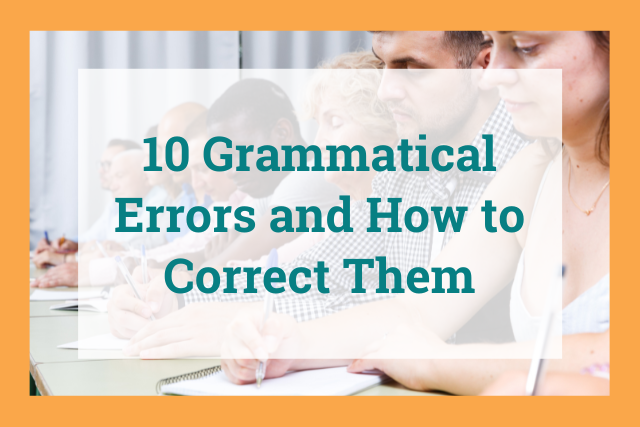
Even the most experienced writers sometimes make grammar errors.
Making a grammar mistake is completely understandable; there's no time for proofreading when you're in full creative flow.
But once you’ve drafted your story or article, it’s important to take a step back and make sure your sentences are constructed correctly.
So, what are the most frequent grammar errors you should watch out for?
This article will discuss the top ten most common grammar mistakes and how to fix them.
What Are Grammatical Errors?
Before we get into the list of most common grammatical errors, let’s start with a quick reminder of what counts as a grammatical error.
Grammatical Errors Meaning
A grammatical error is an instance of faulty or controversial language use. It makes it hard for the reader to understand what you're saying.

There are many kinds of writing mistakes, and it's important to distinguish grammar errors from other mistakes.
Grammar errors are different from factual errors, which occur when you use incorrect information in your writing.
Grammar errors are also different from typographical errors, which occur when you press the wrong key on your keyboard.
Most often, grammar mistakes occur when you construct an incorrect sentence.
For example, if you mix up two commonly confused words, or if you string two independent clauses together without an appropriate conjunction, those are grammar mistakes.
Luckily, the English language has an established set of grammar rules, so there’s usually a right and wrong answer when it comes to grammar mistakes.
As long as you learn the most common grammatical errors, and keep an eye out for them, you can make sure your writing is clean, successful, and error-free.
What Are the 10 Most Common Grammatical Errors?
Let's look at the ten most common grammar mistakes in the English language and how you can fix them in your own writing.
Error #1: Commas
One of the most common grammar mistakes is the incorrect use of commas. Commas are used for three purposes:
- To separate words in a list
- To join compound sentences
- After introductory phrases
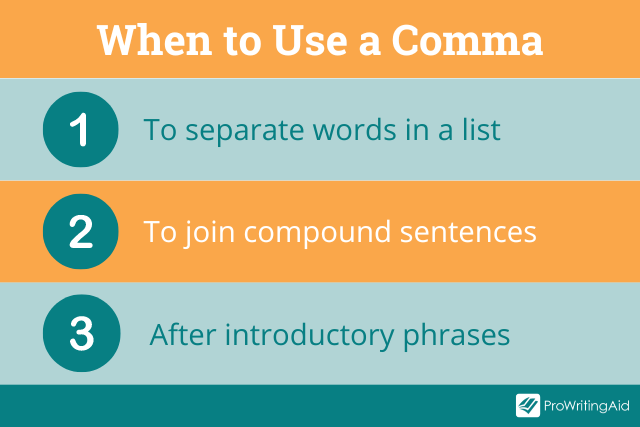
The first reason to use commas is to separate words in a list. You should include a comma between each item in a list, so it's clear that they're separate items.
Here are some examples of how to use commas to separate items in a list:
- You can invite your friends Tom, Betty, George, and Susan to come over for dinner tonight.
- Do you want whipped cream, chocolate syrup, or rainbow sprinkles on your ice cream sundae?
- I need to brush my teeth, do my chores, and finish my homework before I watch TV.
The second reason to use commas is to separate clauses in a compound sentence.
A compound sentence is a sentence that connects two independent clauses. With compound sentences, each clause can stand on its own as a separate and complete sentence.
Usually, these clauses are connected with a coordinating conjunction like and, or, or but. A comma must be used to divide the two clauses.
Here are some examples of how to use commas to divide a compound sentence:
- I like my coffee black, and he likes his coffee with cream and sugar.
- Do you want to come to the store with me, or do you want to stay at home?
- We've had a great time together, but I just don't see a long-term future for the two of us.
You should also use a comma after introductory phrases, such as after, although, however, indeed, unless, before, but, and, yet, so, etc. Without this, the passage becomes a run-on sentence.
Here are some examples of how to use commas after introductory phrases:
- Every morning, I go on a two-mile run to improve my cardiovascular health.
- Although he's been very generous, I don't think it would be wise to continue relying on his help.
- After we went to the store, we went straight home to put our groceries in the fridge.
A good rule of thumb is: if you pause when you say the sentence, put a comma where you paused.
Error #2: Subject/Verb Agreement
Another one of the most common grammar errors is to have a subject and a verb that don't agree in number.
Whenever a sentence has a single subject, it should use a singular verb (such as "he is"). When a sentence has multiple subjects, it should use a plural verb (such as "they are").
Here are some examples of subject/verb agreement:
- Incorrect: "My school have strict teachers, who always punish us for tardiness." Correct: "My school has strict teachers, who always punish us for tardiness."
- Incorrect: "The shelf of books are already full." Correct: "The shelf of books is already full."
- Incorrect: "Each of us are getting good grades in class.” Correct: “Each of us is getting good grades in class.”
Error #3: Pronoun Usage
Pronoun mistakes occur in sentences where the pronoun does not agree in number with the noun to which it refers.
If you have a plural subject ("Sally and Timmy"), the pronoun you use to refer to that subject should always be plural ("they," "themselves").
If you have a singular subject ("Sally"), the pronoun you use to refer to that subject should always be singular ("she," "herself").
Pronoun errors are easy to fix. Simply switch to the correct pronoun, and your sentence will make sense again.
Here are some examples of how to use pronouns correctly:
- Incorrect: "It's every man for themselves out here." Correct: "It's every man for himself out here."
- Incorrect: "The puppies were so excited, she jumped on me when I walked into the shelter." Correct: "The puppies were so excited, they jumped on me when I walked into the shelter."
- Incorrect: "I told my kids to put his own toys away when he finished playing with them." Correct: "I told my kids to put their own toys away when they finished playing with them."
Error #4: Apostrophe Usage
Many writers incorrectly use apostrophes.
There are many reasons to use apostrophes, but the two main ones are:
- To create a contraction
- To make a noun possessive
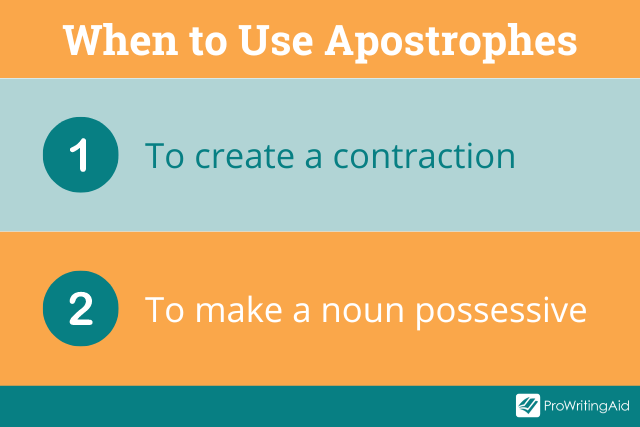
A contraction is when you shorten words or connect words, often by removing letters. You should put an apostrophe in the place where letters have been removed.
Here are some examples of apostrophes that create contractions:
- "Is not" becomes "isn't"
- "Could have" becomes "could've"
- "She had" becomes "she'd"
The second purpose for apostrophes is to denote possession. In this case, you place the apostrophe before the additional s.
However, it’s important to remember apostrophes are never used after a possessive pronoun, such as his, hers, their, theirs, yours or ours.
Here are some examples of how to use apostrophes to denote possession:
- Correct: "I am going to Florida to meet my father's new girlfriend."
- Correct: "The teacher's blackboard is covered with chalk smudges, so it is hard to read what he is writing."
- Incorrect: “The apartment next door is her’s.” Correct: “The apartment next door is hers.”
Error #5: Colons and Semicolons
Writers often confuse the functions of colons and semicolons, which can lead to punctuation mistakes.
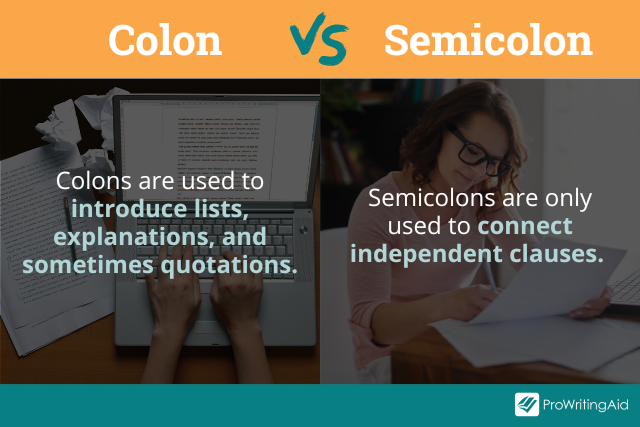
You use a colon when you’re about to provide a list, an explanation, or sometimes a quotation. Here are some examples of how to correctly use colons:
- "The local diner offers three ice cream flavors: chocolate, strawberry, and vanilla."
- "This was his dream car: a silver Cadillac."
- "My father always told me: ‘Keep your friends close, and your enemies closer.’"
Semicolons should only be used to connect independent clauses. If each clause is a complete sentence, you can divide them with a semicolon instead of with a coordinating conjunction and a comma.
Here are some examples of how to correctly use semicolons:
- "I've never eaten chocolate; I'm actually allergic to it."
- "She had never seen a rainbow before; it was even more beautiful than she'd imagined."
- "You don't know what you did wrong; it feels like everyone's blaming you for no reason."
Error #6: Dangling Modifiers
A modifier is a word or phrase that gives the reader more information about a subject.
It's important to make sure your modifiers are attached to the right subject in the sentence.
If they are not, the modifier becomes a dangling modifier, which is a word or clause that's attached to the incorrect subject.
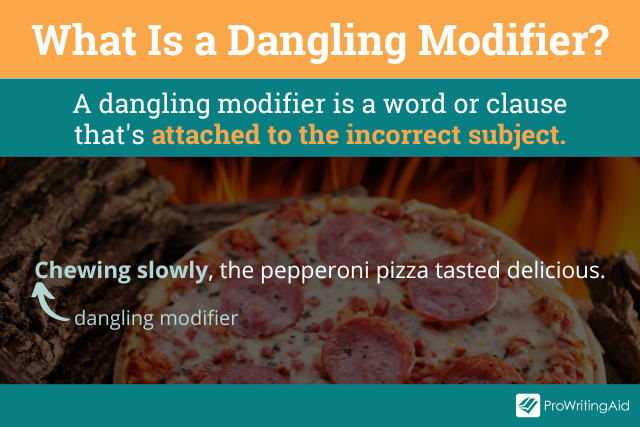
If you find a dangling modifier in your writing, don't worry—they're easy to fix. You can leave the modifier the way it is and change the subject of the sentence to be the person or object the modifier describes.
Here are some examples of dangling modifiers and how to fix them:
- Incorrect: "Chewing slowly, the pepperoni pizza tasted delicious." Correct: "Chewing slowly, I thought the pepperoni pizza tasted delicious."
- Incorrect: "Dressed up in various costumes, candy is collected by thousands of trick-or-treaters every Halloween." Correct: "Dressed up in various costumes, thousands of trick-or-treaters collect candy every Halloween."
- Incorrect: "Kicking and screaming, the exasperated father dragged his toddler out of the grocery store." Correct: "Kicking and screaming, the toddler was dragged out of the grocery store by his exasperated father."
Error #7: Sentence Fragments
Sentence fragments occur when you write a sentence that doesn't include a subject, a verb, and a complete thought.
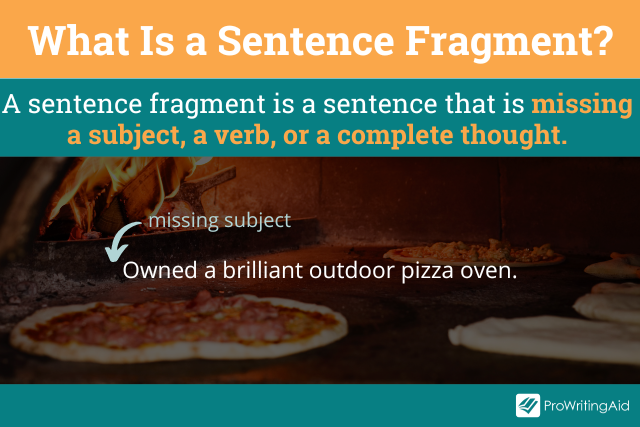
If you've forgotten to include a subject or a verb in the sentence, that means your sentence is incomplete. That's why we call it a fragment—it's only one part of the whole.
You can also create a sentence fragment by failing to form a complete thought. For example, “I ran to” contains a subject and a verb, but is not a complete sentence.
To fix a sentence fragment, you can either attach it to an independent clause, insert the missing subject or verb, or finish the thought.
Here are some examples of sentence fragments and how to fix them:
- Incorrect: "Had strange and vivid dreams last night." Correct: "I had strange and vivid dreams last night."
- Incorrect: "A young girl in the corner, holding a red balloon." Correct: "A young girl stood in the corner, holding a red balloon."
- Incorrect: "The legendary ship was manned by pirates. Sailed out toward the horizon one day, never to be seen again." Correct: "The legendary ship, which was manned by pirates, sailed out toward the horizon one day, never to be seen again."
Error #8: Their vs There
There can either be an adverb, adjective, or pronoun depending on how it is used, and usually indicates place.
Their is a plural possessive pronoun that means “belonging to them.”
These two words are an example of confusing homophones—words that sound the same but have different spellings and meanings.
It’s important to make sure you’re using the right word so your reader doesn’t get confused.
Here are some examples of how to use their correctly:
- "Sarah and Jane asked if you want to have dinner at their apartment tonight."
- "Did your parents leave their toothbrushes at the hotel?"
- "My friends played one of their classic pranks on me again."
And here are some examples of how to use there correctly:
- "We'll head over there immediately."
- "Do you see that woman standing there?"
- "How can you not see it? It's right there!"
Error #9: Which vs That
Mixing up which and that is a common grammatical error made by experienced and novice writers alike. These two words serve similar functions in a sentence, but they are not interchangeable.
The word which should be used to introduce non-restrictive clauses—an additional, but not essential, part of a sentence.
The word that introduces a restrictive clause, which is a necessary part of a sentence that cannot be removed.
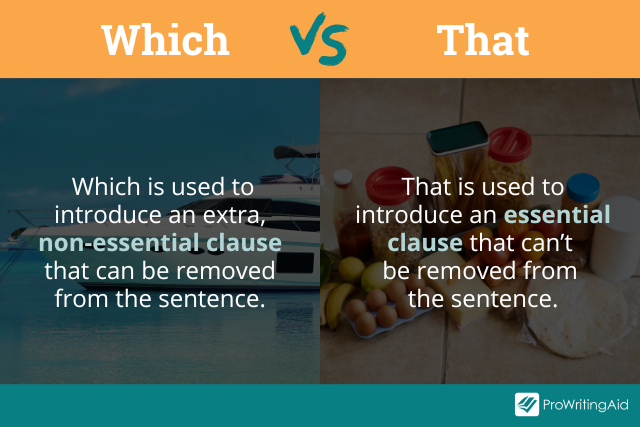
This error has a simple solution: figure out if the clause you're adding is restrictive or non-restrictive, and choose the right word to match.
Here are some examples of how to use which and that correctly:
- Incorrect: "I want a puppy, which won't bite me when we play." Correct: "I want a puppy that won't bite me when we play."
- Incorrect: "This cake that has cherries on top is delicious." Correct: "This cake, which has cherries on top, is delicious."
- Incorrect: "My new laptop that has more processing power than my old one is working beautifully." Correct: "My new laptop, which has more processing power than my old one, is working beautifully."
Error #10: Who vs Whom
Who and whom are two commonly confused pronouns.
Who refers to the subject of a sentence, while whom refers to the object of a sentence.
In English, subjects do the action, while objects receive the action.
Here's another way to think of it: who should be used to describe someone performing an action (“Who sent this email?”), while whom should be used to describe someone on the receiving end of an action (“To whom should I send this email?”)
Here are some examples of how to use these two words correctly. The first example in each set describes the subject of the sentence; the second describes the object of the sentence.
- "Who is your favorite?" vs "Whom do you like more?"
- "Who will ask you to the school dance?" vs "With whom do you want to go to the school dance?"
- "Who will receive this invitation?" vs "To whom should I address this invitation?"
Why You Should Avoid Improper Grammar
The main reason for avoiding improper grammar is to improve the clarity of your writing.
Poorly structured sentences make it hard for readers to understand what you’re saying, which makes it harder for you to communicate effectively.
Furthermore, grammatical mistakes can make you lose credibility in the eyes of your readers.
They might assume you have poor writing skills, or that you haven’t bothered to read and edit your writing. If you don’t care about your writing, why should your readers?
You can use an online grammar checker like ProWritingAid to catch your grammatical errors. With just a few clicks, you can run a comprehensive grammar check.
An online grammar checker will highlight all of your misused words, punctuation errors, spelling errors, and more.
On a deeper level, ProWritingAid will look at your sentence structure to catch subtle errors and help you improve the clarity of your writing.
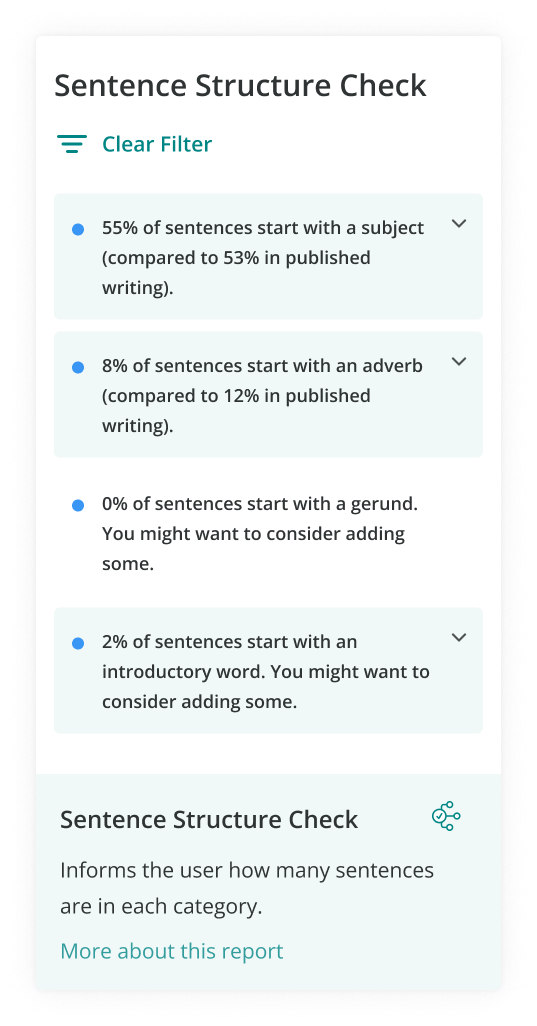
English is not an easy language to master. So, if this article has helped you in any way, here’s to your improvement. Happy writing!


